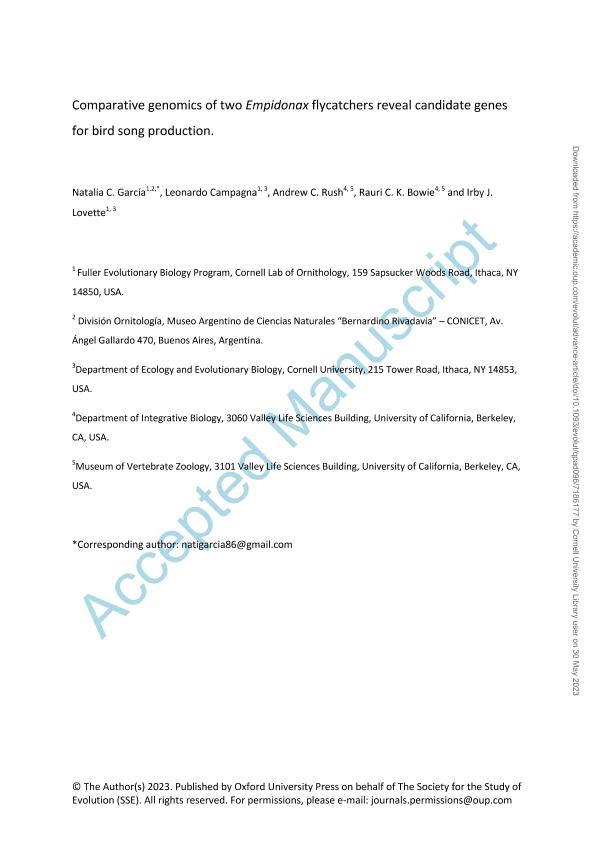Artículo
Comparative genomics of two Empidonax flycatchers reveal candidate genes for bird song production
García, Natalia Cristina ; Campagna, Leonardo
; Campagna, Leonardo ; Rush, Andrew C.; Bowie, Rauri C. K.; Lovette, Irby J.
; Rush, Andrew C.; Bowie, Rauri C. K.; Lovette, Irby J.
 ; Campagna, Leonardo
; Campagna, Leonardo ; Rush, Andrew C.; Bowie, Rauri C. K.; Lovette, Irby J.
; Rush, Andrew C.; Bowie, Rauri C. K.; Lovette, Irby J.
Fecha de publicación:
05/2023
Editorial:
Wiley Blackwell Publishing, Inc
Revista:
Evolution
ISSN:
0014-3820
Idioma:
Inglés
Tipo de recurso:
Artículo publicado
Clasificación temática:
Resumen
Whole-genome-level comparisons of sister taxa that vary in phenotype against a background of high genomic similarity can be used to identify the genomic regions that might underlie their phenotypic differences. In wild birds, this exploratory approach has detected markers associated with plumage coloration, beak and wing morphology, and complex behavioral traits like migration. Here, we use genomic comparisons of two closely related suboscine flycatchers (Empidonax difficilis and E. occidentalis) and their hybrids to search for candidate genes underlying their variation in innate vocal signals. We sequenced the genomes of 20 flycatchers that sang one of two species-specific pure song types and 14 putative hybrid individuals with intermediate song types. In the resulting genomic comparisons, we found six areas of high differentiation that may be associated with variation in nonlearned songs. These narrow regions of genomic differentiation contain a total of 67 described genes, of which three have been previously associated with forms of language impairment and dyslexia in humans and 18 are known to be differentially expressed in the song nuclei regions of the avian brain compared with adjacent parts of the avian brain. This “natural experiment” therefore may help identify loci associated with song differences that merit further study across bird lineages with both learned and innate vocalizations.
Palabras clave:
avian song
,
candidate genes
,
genomics
Archivos asociados
Licencia
Identificadores
Colecciones
Articulos(MACNBR)
Articulos de MUSEO ARG.DE CS.NAT "BERNARDINO RIVADAVIA"
Articulos de MUSEO ARG.DE CS.NAT "BERNARDINO RIVADAVIA"
Citación
García, Natalia Cristina; Campagna, Leonardo; Rush, Andrew C.; Bowie, Rauri C. K.; Lovette, Irby J.; Comparative genomics of two Empidonax flycatchers reveal candidate genes for bird song production; Wiley Blackwell Publishing, Inc; Evolution; 5-2023; 1-28
Compartir
Altmétricas



